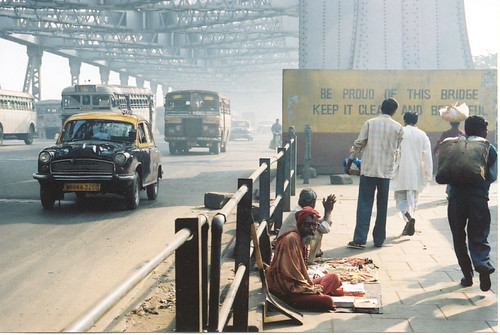No Cash for Calcutta’s Clunkers: Indian city of Calcutta bans commercial vehicles more than 15 years old; Police start seizing clunkers (4,000 private buses, 6,800 taxis and more than 95 percent of the total fleet of 65,000 auto-rickshaws); Transport workers driving vehicles affected by the ban go on strike
(Source: BBC)
For five days, millions of people in the Indian city of Calcutta have endured long queues in the stifling heat at bus and taxi stands, metro railway counters and on auto-rickshaw routes.
They are braving both the humidity and the rain in the hope that what has been termed the city’s “great transport mess” will finally be cleared up.
While the difficulties of getting from A to B may be greater now than at any time over the last two decades, the air of the city is much cleaner than before 1 August.
That was when police started seizing all pollution-emitting pre-1993 vehicles to ensure they are kept off the roads in keeping with a Calcutta High Court order. The decks were cleared for the government to seize the buses, mini buses, taxis and auto rickshaws after the Supreme Court Friday refused to stay the high court order banning commercial vehicles built before 1993.
Police and Rapid Action Force personnel were deployed in large number to prevent disturbances, as security personnel moved alongside motor vehicles department officials to identify the banned vehicles on the city streets.
Nearly 4,000 private buses, 6,800 taxis and more than 95 percent of the total fleet of 65,000 auto-rickshaws have been barred from the Kolkata Metropolitan Area following the court order.
Meanwhile, following main opposition Trinamool Congress chief and Railways Minister Mamata Banerjee’s accusation that government departments like the police as also the Kolkata Municipal Corporation were running vehicles over 15 years old, Police Commissioner Goutam Mohan Chakraborty said the city police have decided not to deploy such vehicles.
A survey done by the Calcutta-based Saviour and Friend of Environment (Safe) says that around the city’s four most polluted intersections – the Dunlop crossing, the Shyambazar five-point crossing, Park Circus and the Rashbehari Avenue-SP Mukherjee Road crossing – hydrocarbon levels more than halved.
Auto-rickshaw drivers have tried to keep public transport off the roads
That is important because high hydrocarbon levels have been blamed for an increase in liver and kidney illnesses as well as higher level of cancer.
With less traffic on the roads, the oxygen count shot up by around 15 to 20%, leading to a drop in the percentages of carbon dioxide and carbon monoxide.
Suspended particulate matter, the main cause of bronchial diseases that makes Calcutta the asthma capital of India, dropped by 50%.
“Calcutta is back to low pollution levels it enjoyed until about 20 years ago,” said Safe’s convenor, Sudipto Bhattacharya.
“The vigil has to continue and none of the 15-year-old vehicles or those older should be allowed to go back on to the streets.”
Mr Bhattacharya said that Safe’s findings vindicated the green activists’ stand against older vehicles.
Many other fresh air fans agree with him.
“The sharp drop in the hydrocarbon level proves that older vehicles are the major culprits,” said green activist Subhas Datta, who lobbied the city’s high court to seek the withdrawal of all vehicles older than 15 years.
“They emit unburnt fuel into the air that pushes up the hydrocarbon level to dangerous levels. Let us hope that Calcutta will breathe freely from now on.”
Back in February Calcutta Tramways announced that it would running the buses it operates on a B20 biodiesel blend — a move which, while motivated by financial reasons, is expected to cut pollution from the buses by 35%
Click here to read the entire article.

